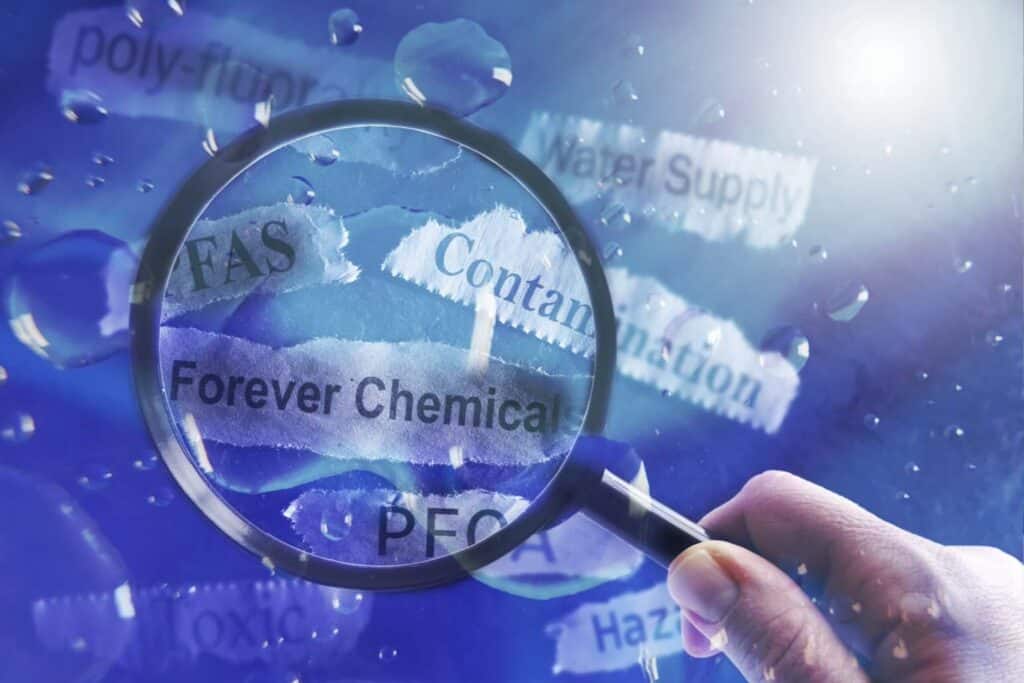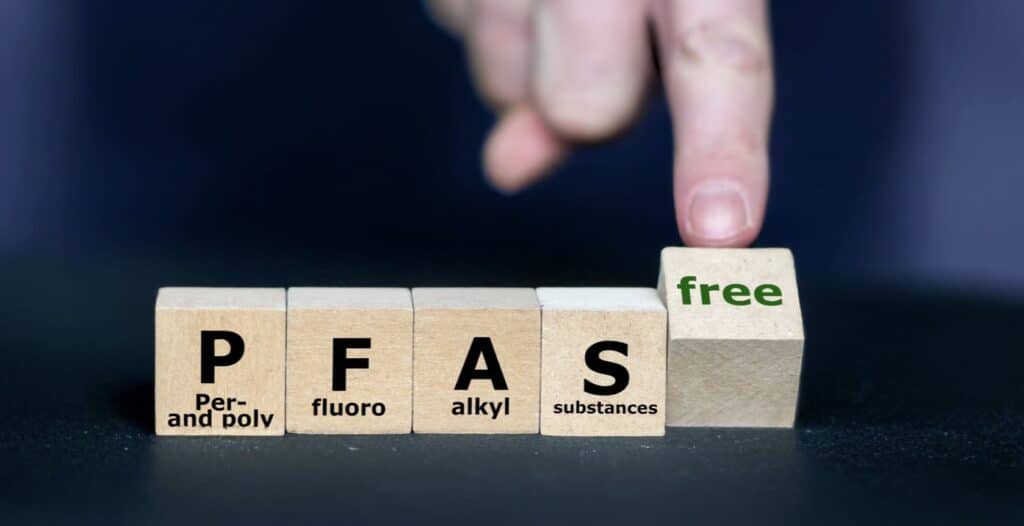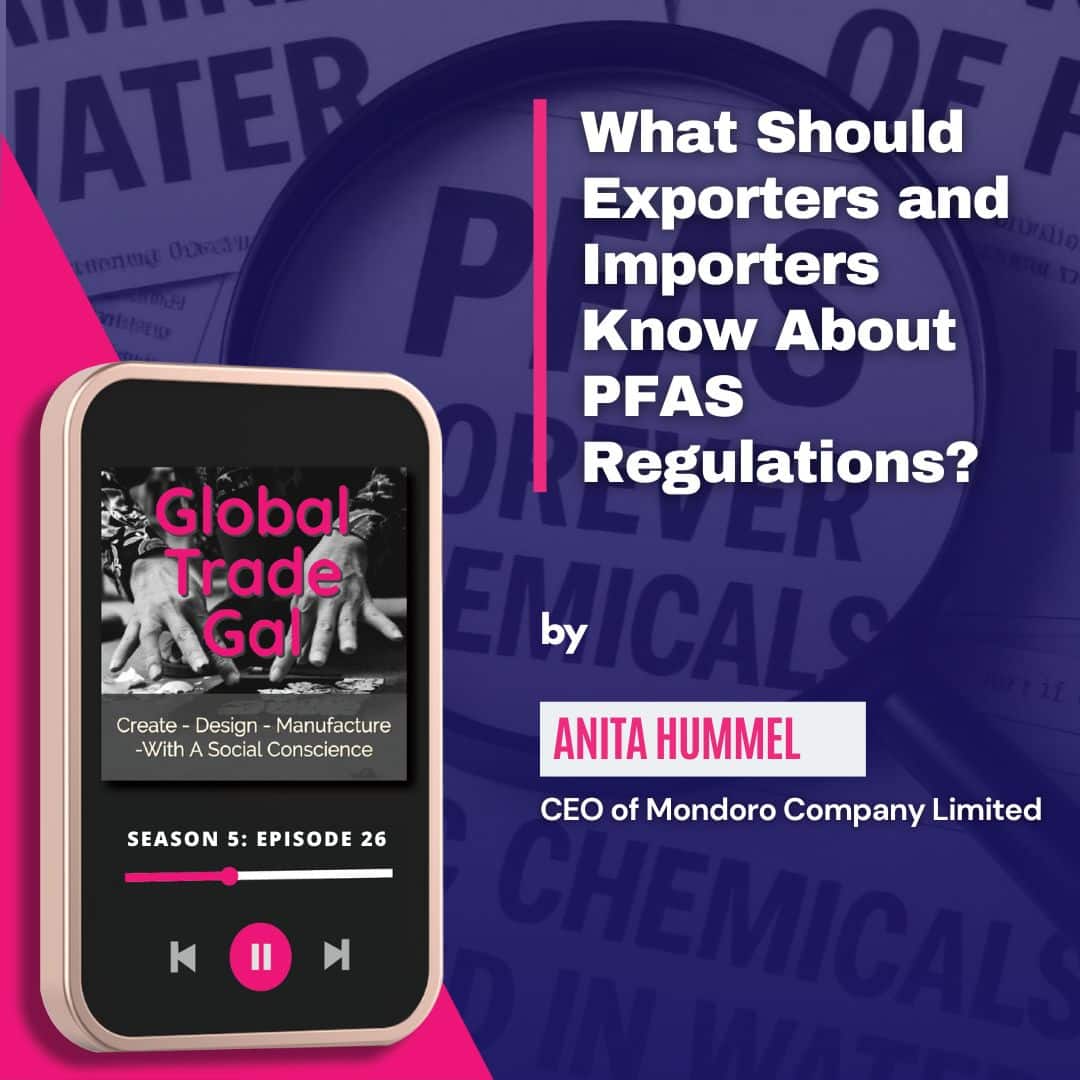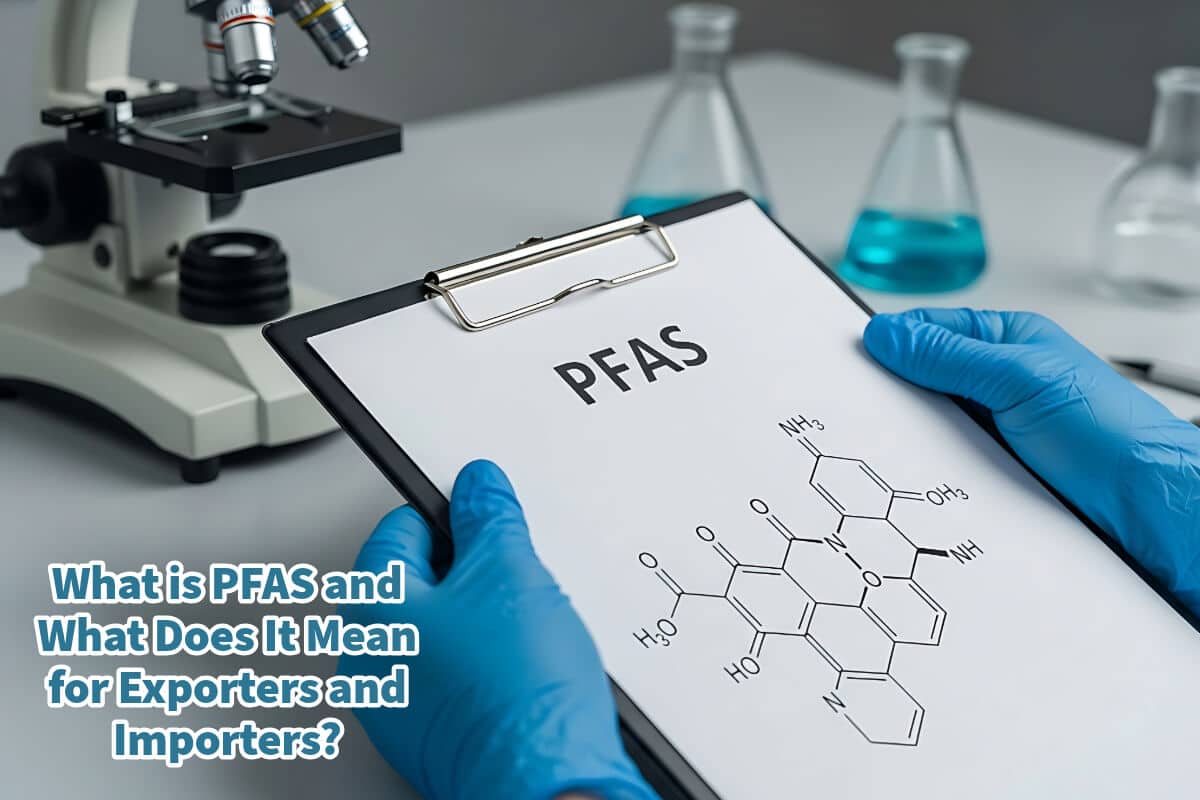The global trade landscape is constantly evolving, shaped by new regulations, environmental concerns, and consumer awareness.
One of the pressing issues facing exporters and importers today is the growing scrutiny surrounding PFAS (Per- and Polyfluoroalkyl Substances). Known as “forever chemicals,” PFAS have garnered attention due to their environmental persistence, potential health risks, and widespread use in various industries. For businesses engaged in international trade, understanding PFAS regulations, their presence in products, and compliance requirements is crucial to staying competitive and avoiding legal or reputational risks.
Table of Contents
- What Are PFAS?
- New USA Regulations on PFAS
- Products Where PFAS Are Commonly Found
- Testing for PFAS: Ensuring Compliance and Safety
- Steps to Conduct PFAS Testing:
- Related Questions
Read on as we will explore what PFAS are, delve into the new USA regulations concerning PFAS, identify the types of products where PFAS are commonly found, and discuss how businesses can ensure compliance through certified laboratory testing.
This guide is tailored for exporters, importers, and manufacturers, particularly those working with Mondoro.com, to help navigate the complexities of PFAS in global trade.
What Are PFAS?

PFAS, or Per- and Polyfluoroalkyl Substances, are a group of synthetic chemicals that have been used in industrial and consumer products since the 1940s.
These substances are characterized by their strong carbon-fluorine bonds, which make them resistant to heat, water, and oil. While these properties make PFAS highly useful in various applications, they also contribute to their persistence in the environment and human body, earning them the nickname “forever chemicals.”
Key Characteristics of PFAS:
- Durability: PFAS are resistant to degradation, meaning they can remain in the environment for decades.
- Widespread Use: PFAS are found in thousands of products, from non-stick cookware to firefighting foam.
- Environmental Impact: PFAS can contaminate soil, water, and air, posing risks to ecosystems.
- Health Concerns: Studies suggest that prolonged exposure to PFAS may lead to health issues such as cancer, hormonal disruption, and developmental problems.
Common Types of PFAS:
- PFOA (Perfluorooctanoic Acid): Used in manufacturing non-stick coatings.
- PFOS (Perfluorooctanesulfonic Acid): Found in stain-resistant fabrics and firefighting foam.
- GenX Chemicals: A newer generation of PFAS used as alternatives to older compounds.
New USA Regulations on PFAS
The United States has taken significant steps to address the environmental and health risks posed by PFAS. Recent regulations aim to limit the use, production, and disposal of materials containing PFAS.
Exporters and importers must stay informed about these changes to ensure compliance and avoid penalties.
Key Regulatory Developments:
- EPA’s PFAS Strategic Roadmap (2021-2024):
The Environmental Protection Agency (EPA) launched a comprehensive plan to regulate PFAS. The roadmap includes:
- Setting enforceable limits for PFAS in drinking water.
- Requiring manufacturers to report PFAS usage and emissions.
- Accelerating research on PFAS toxicity and remediation methods.
- TSCA Reporting Requirements:
Under the Toxic Substances Control Act (TSCA), companies are required to disclose information about PFAS in their products, including details about manufacturing processes and environmental releases. - State-Level Bans:
Several states, including California, Maine, and Washington, have enacted bans on PFAS in specific products such as food packaging, textiles, and firefighting foam. - FDA Oversight:
The Food and Drug Administration (FDA) is reviewing the use of PFAS in food contact materials, with potential restrictions on packaging and processing equipment.

Implications for Exporters and Importers:
- Increased Documentation: Businesses must provide detailed information about PFAS content in their products.
- Supply Chain Audits: Companies should evaluate their supply chains to identify sources of PFAS contamination.
- Market Access Challenges: Products containing PFAS may face restrictions or bans in specific markets.
- Legal Risks: Non-compliance with PFAS regulations can result in fines, litigation, and reputational damage.
Products Where PFAS Are Commonly Found
PFAS are ubiquitous in modern manufacturing, making it essential for exporters and importers to understand where these substances might be present. Below is a list of industries and products commonly associated with PFAS:
1. Textiles and Apparel
PFAS are used to create water-resistant, stain-resistant, and wrinkle-free fabrics. They are commonly found in:
- Outdoor gear such as jackets and tents.
- Upholstery and carpets.
- Uniforms and workwear.
2. Food Packaging
PFAS provide grease resistance in food packaging materials, including:
- Fast-food wrappers and containers.
- Microwave popcorn bags.
- Pizza boxes.
3. Non-Stick Cookware
Teflon and other non-stick coatings often contain PFAS to enhance durability and heat resistance.
4. Firefighting Foam
Aqueous Film Forming Foam (AFFF), used to extinguish fires, is a significant source of PFAS contamination.
5. Electronics
PFAS are used in semiconductors, circuit boards, and other electronic components for their heat resistance and electrical insulation properties.
6. Cosmetics
Certain cosmetics, such as waterproof mascaras and long-lasting lipsticks, contain PFAS to improve performance and durability.
7. Automotive and Aerospace
PFAS are used in fuel-resistant seals, hydraulic fluids, and coatings for vehicles and aircraft.
8. Medical Devices
PFAS are found in surgical gowns, tubing, and other medical equipment due to their chemical resistance and durability.
Testing for PFAS: Ensuring Compliance and Safety

Given the widespread use of PFAS and the growing regulatory scrutiny, exporters and importers must take proactive measures to ensure their products comply with international standards. One of the most effective ways to determine the presence of PFAS is through product testing in certified laboratories.
Why Test for PFAS?
- Regulatory Compliance: Testing ensures adherence to local, state, and federal regulations.
- Market Access: Products free from PFAS are more likely to be accepted in markets with strict environmental standards.
- Consumer Trust: Demonstrating a commitment to sustainability and safety can significantly enhance a brand’s reputation.
Certified Laboratories for PFAS Testing:
- Bureau Veritas:
Bureau Veritas offers comprehensive PFAS testing services, helping businesses identify and quantify PFAS in their products. Their expertise spans various industries, including textiles, food packaging, and electronics. - SGS:
SGS is a global leader in testing and certification, offering PFAS analysis services to manufacturers, exporters, and importers. Their advanced methods ensure accurate results and compliance with international regulations.
Steps to Conduct PFAS Testing:
- Identify High-Risk Products: Analyze your product portfolio to identify items that are likely to contain PFAS.
- Choose a Certified Laboratory: Collaborate with reputable labs, such as Bureau Veritas or SGS, for reliable testing.
- Review Test Results: Evaluate the findings to assess compliance and identify areas for improvement.
- Implement Changes: Modify manufacturing processes or source alternative materials to reduce PFAS content.
PFAS pose significant challenges for exporters and importers, but they also present opportunities for businesses to demonstrate leadership in environmental stewardship and compliance.
By understanding what PFAS are, staying informed about new USA regulations, identifying high-risk products, and conducting certified testing, companies can navigate the complexities of PFAS in global trade.
For businesses working with Mondoro.com, this knowledge is especially crucial. Mondoro.com is dedicated to helping exporters and importers stay informed about regulatory changes, ensuring their products meet the highest standards of safety and sustainability.
Partnering with certified laboratories, such as Bureau Veritas or SGS, can provide the assurance you need to enter markets worldwide confidently. By prioritizing compliance and transparency, you can build trust with consumers, strengthen your brand, and contribute to a cleaner, safer planet.
Contact Mondoro Today!
If you’re unsure about PFAS content in your products, consider reaching out to Mondoro.com for guidance. With expertise in international trade and compliance, Mondoro.com can help you navigate PFAS regulations, connect you with certified testing laboratories, and ensure your products meet global standards.
Let’s work together to create a sustainable future for global trade.
Listen To Our Podcast About What Should Exporters and Importers Know About PFAS Regulations?
Below or By clicking here.

If you are interested in seeing how Mondoro can be a valuable partner for your home decor and home furnishing products – we would love to talk to you to see how we can help you.
Find out more about how Mondoro can help you create, develop, and manufacture excellent home decor and home furniture products – don’t hesitate to contact me, Anita. Check out my email by clicking here, or become a part of our community and join our newsletter by clicking here.
Mondoro gives out a FREE Lookbook to anyone interested. You can receive a copy of our latest Lookbook by clicking here.
Listen to our Podcast called Global Trade Gal. You can find it on all major podcast platforms. Try out to listen to one of our podcasts by clicking here.
Subscribe to our Mondoro Company Limited YouTube Channel filled with great videos and information by clicking here.
Related Questions
Challenges and Triumphs in Sourcing Raw Materials for High-Quality Home Decor
Quality is paramount in the world of home decor. This is especially true for medium—to high-end products, where customers expect beautiful designs, exceptional craftsmanship, and durability.
At Mondoro, we are dedicated to delivering excellence, beginning with sourcing the finest raw materials. However, sourcing high-quality materials is no easy feat, especially when it involves navigating international borders, complex logistics, and stringent quality standards.
You can discover more by reading our blog Challenges and Triumphs in Sourcing Raw Materials for High-Quality Home Decor by clicking here.
Sourcing Sustainable Materials in Southeast Asia for Home Decor
In a world where climate change, deforestation, and environmental degradation are daily headlines, design has a new mandate: it must be beautiful, functional, and sustainable. At Mondoro, we believe the future of home decor lies at the intersection of thoughtful design and ethical sourcing. For us, sustainability isn’t a buzzword—it’s a business model.
You can learn more by reading our blog Sourcing Sustainable Materials in Southeast Asia for Home Decor by clicking here.
What Is Ethical Home Decor Manufacturing?
In a world where consumer values are shifting toward transparency, accountability, and sustainability, one question continues to surface across the home decor industry: What does ethical manufacturing mean?
For Mondoro, ethical manufacturing is not just a concept—it’s a practice embedded in every step of our development, production, and delivery of home decor products. From factory floors in Vietnam to the materials we source and the way we treat our artisans, our mission is to set a gold standard for ethical home decor manufacturing.
You can read our blog about What Is Ethical Home Decor Manufacturing? by clicking here.

